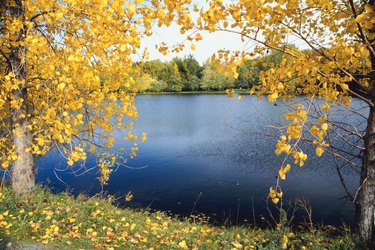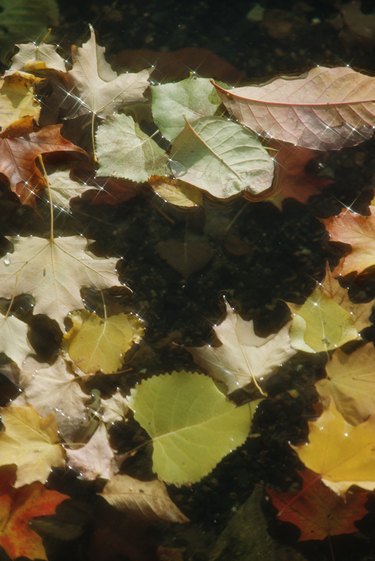
Early pioneers quickly recognized the life-saving qualities of cottonwoods (Populus spp.) as they traveled across the prairies. A shimmering grove of trees standing above the prairie grasses indicated both shade and wood for repairs or construction. It also represented water, because this tree species is never far from a source. In autumn the bright yellow groves were visible from long distances, but yellow leaves in other seasons could indicate the trees were struggling.
Cottonwood Species
Video of the Day
Cottonwood trees are native throughout North America and are considered river trees. The three most common species are Eastern cottonwood (Populus deltoides), which is present everywhere except for Pacific coast states, Nevada and Idaho; Fremont cottonwood (Populus fremontii S. Watson), which grows in southwestern states and California; and plains cottonwood (Populus deltoides var. occidentalis), a subspecies of eastern cottonwood. The many subspecies and varieties of cottonwoods all possess similar growth habits and requirements.
Video of the Day
Seasonal Color Change

Healthy cottonwoods turn yellow when their growth requirements are met – glowing yellow in fall and bright green in spring. Chlorophyll creates the green in leaves, which are producing carbohydrates for the tree's growth. At the end of the growing season, cooler temperatures trigger a slowing of chlorophyll production and reveal the leaves' always-present yellow pigment, which are masked by dominant chlorophyll earlier in the year.
Nonseasonal Yellowing
Cottonwood leaf scorch results from drought and environmental stress and leads to yellowing of leaves that quickly turn brown. Heat stress, water-soaked and oxygen-deprived soil conditions and lack of light or minerals create unfavorable conditions for maintaining chlorophyll production. If yellowing happens early in the growing season, property owners should be concerned.
Mineral Deficiencies
Chlorophyll is sensitive to many factors and is unstable. Mineral deficiencies in woody plants occur because of the root's inability to access nutrients. Check for water-logged soil, root diseases, physical damage to the roots and either elevated or low soil pH. Ideal soil pH for cottonwood species is 5.5 to 7.5.
Iron Chlorosis
Deficiency in one mineral, iron, allows the unmasking of yellow pigments by reducing chlorophyll production. Yellowing on leaves with the veins remaining green may mean the cottonwood tree can't absorb iron from soil. The cause may be elevated soil pH. A quick fix involves spraying iron sulfate on the leaves. Iron-rich soil supplements in the root zone help small trees; larger trees require injections.
Growth Requirements
Native cottonwoods reach heights of 70 feet within 20 years, forming valuable shade trees. This consumes a lot of water, and their shallow root systems are efficient water seekers. Their native habitats include reliable water sources that allow quick establishment. When planted in yards, these clever trees locate cracks in plumbing often pushing under driveways to exploit the neighbor's leaky plumbing. Make sure your cottonwoods are planted in an area where they receive sufficient water so that their leaves remain healthy -- without stealing it from an unreliable source.
Leaf Scorch
Prolonged periods of drought accompanied by hot, dry winds establish an environment for rapid water loss through transpiration, with cottonwoods losing more water through the leaves than the roots can take up from the ground. When water drops beyond the roots' reach and they can't locate additional sources, the tree can't maintain water balance. Cottonwoods are vulnerable to drought; under these conditions, leaves turn yellow and then brown – a drought symptom called leaf scorch.
Site Concerns
Fast-growing cottonwood trees have brittle wood that, when combined with shallow root systems, becomes a risk in urban settings. In natural settings, these attractive trees create memorable sights and sounds, but they have no place next to houses. Construction close to cottonwoods damages their roots and decreases access to water, leaving the tree unstable. When the trees are near structures, consider yellow leaves during the growing season as indicators of crowding issues and reasons for concern.
- Auburn University South Forest Nursery Management Cooperative: Cottonwood
- North Dakota State University: Trees Handbook: Cottonwood
- Northern State University: Eastern and Plains Cottonwood
- Texas A&M Forest Service: When Autumn Leaves Begin To Fall, Why Do They Turn Colors?
- Great Plains Nature Center: Cottonwood
- University of California Agriculture and Natural Resources: Mineral Deficiencies
- University of Illinois Extension: Leaf Scorch of Woody Plants
- University of Missouri Extension Infonet: Yellow Leaves, Iron Chlorosis
- U.S. Department of Agriculture Natural Resources Conservation Service: Populus Fremontii S. Watson
- UCLA Mildred E. Mathias Botanical Garden: Xanthophylls
- University of Wisconsin-Madison Chemistry: The Chemistry of Autumn Colors
- University of Nebraska-Lincoln Extension: Prevent Leaf Scorch in Trees With Deep Soaking
- U.S. Department of Agriculture Natural Resources Conservation Service: Populus Deltoides W. Bartram ex Marshall